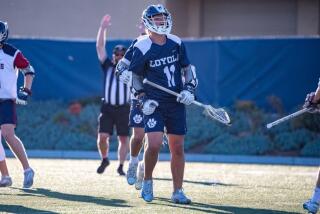Loyola Lacrosse Team Sticks to Its Goals : Club sports: Thanks to hard work by the coach and players, this West Coast club is becoming competitive in a sport dominated by East Coast teams.
- Share via
Lacrosse, you’ve come a long way baby. First an ancient American Indian sport and then an Ivy League college favorite, it has finally made it to Loyola Marymount.
Now a club sport at Loyola, it took the determination of Coach Dave Basile and the dedication of the players to build a credible lacrosse team.
Becoming competitive has been the major goal for Basile since he took over the team three years ago. The team was actually created four years ago but played without a coach for its first season.
To become competitive it needed a coach. So Basile, first entering the scene as a referee for several of their games, decided to take on the job.
“I knew it was just a club sport, but I really wanted to get actively back into lacrosse,” said Basile, a Philadelphia native who teaches at Bishop Montgomery High School.
For the first two years, Basile says, he did everything that he could to keep the team going. He located competition and set up matches. He taught the players the fundamentals. Now that the team has been established, he finally has some help in the form of four assistants with experience in the East.
Club teams in California compete in the West Coast Lacrosse League and are divided into a North and South Division. These are further divided into Divisions 1 and 2. Loyola plays in Southern Division 2. The league spans the state, with teams in the San Francisco area, Chico and Humboldt and San Diego. Arizona and Arizona State are also included.
The best collegiate teams traditionally are on the East Coast. Teams like two-time defending NCAA champ Syracuse, Johns Hopkins, Maryland and the Carolina schools have dominated the scene in the United States. Much of that has to do with the level of attention given to the sport in that area. There are high school programs and summer leagues. It is a high profile sport in parts of the East.
In California, Basile said the best programs are at Whittier College and Santa Barbara.
“Those are the most competitive in California, but they still aren’t anywhere near the level of Syracuse,” Basile said. Loyola beat San Jose State last weekend to improve to 3-4 going into Sunday’s 1 p.m. home game against the University of San Diego.
Lacrosse is a sport some would consider violent. The safety equipment consists of leg pads, padded gloves and a helmet. The only equipment the game itself needs is a pole with a triangular net at the end, a soccer-sized field, two goal nets and a hard rubber ball about the size of a tennis ball.
Players try to score goals by throwing a ball past a goalie. The ball cannot be touched by the player’s hands and must be handled with the stick. Defenders check opponents hockey-style and also slash at the ball with their sticks.
Organization is the key to the game, according to Basile. The players must know what kind of defense and offense is most effective and that, he says, is his job.
Most of Loyola’s players are athletes from California high schools who had never played lacrosse. This means that teaching the fundamentals of the game is the most important aspect of practice.
When the Loyola team started, Basile said, it had only 17 “dedicated players” who showed up for every game, but the roster has grown to 35. Basile’s goal is to have 45 players so that a full-time junior varsity can be created. The second team now only plays when it is certain that everyone is going to be there.
Getting players can be tricky business in club sports, as there is no money to offer scholarships. There is also very little attention garnered from playing on the West Coast when all of the best teams are in the East.
“I can’t really recruit anyone,” Basile said. “The only thing that I can do is offer up (California), the good-looking women and the college as inducements to play here. Mainly I offer the players a change from playing in the cold.”
More to Read
Get our high school sports newsletter
Prep Rally is devoted to the SoCal high school sports experience, bringing you scores, stories and a behind-the-scenes look at what makes prep sports so popular.
You may occasionally receive promotional content from the Los Angeles Times.






